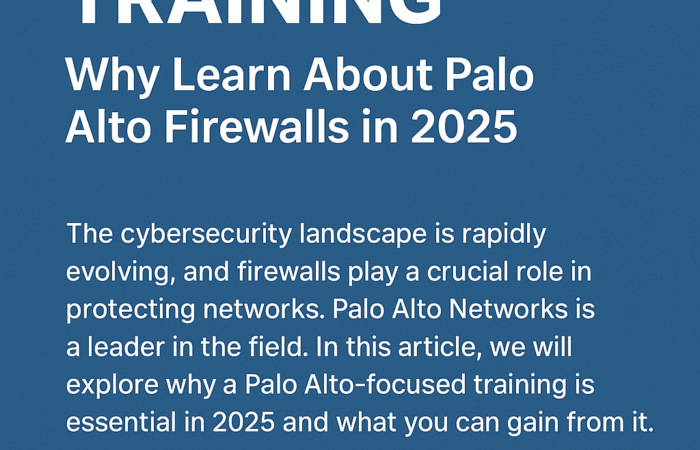Palo Alto Training – Learn Palo Alto Firewalls in 2025

As organizations embrace digital transformation and cloud-first strategies, securing sensitive data across decentralized systems has become a pressing challenge. Traditional security measures often fall short in dynamic, hybrid environments. This is where Forcepoint emerges as a leader—providing unified, intelligent solutions for cloud security and data loss prevention (DLP). Forcepoint’s approach goes beyond legacy security controls. […]

As organizations embrace digital transformation and cloud-first strategies, securing sensitive data across decentralized systems has become a pressing challenge. Traditional security measures often fall short in dynamic, hybrid environments. This is where Forcepoint emerges as a leader—providing unified, intelligent solutions for cloud security and data loss prevention (DLP).
Forcepoint’s approach goes beyond legacy security controls. It integrates human behavior analytics, AI-driven threat detection, and risk-adaptive protection to deliver visibility and control over data—wherever it resides. By combining advanced DLP technologies with cloud-native security solutions, Forcepoint enables enterprises to operate securely in the cloud without sacrificing productivity or compliance.
Organizations today are increasingly reliant on Software-as-a-Service (SaaS) applications like Microsoft 365, Google Workspace, Salesforce, Dropbox, and Slack. At the same time, hybrid and remote workforces introduce complex access patterns and insider risks.
This shift creates two core challenges:
Forcepoint solves these challenges by uniting cloud access security and DLP into a single, behavior-aware platform, enabling businesses to secure data without locking down productivity.
Forcepoint offers a suite of cloud-native security solutions that fall under the Security Service Edge (SSE) framework. These include:
What makes Forcepoint unique is how it integrates DLP directly into all these services—offering real-time visibility and policy enforcement across the cloud, web, email, and endpoint.
At the heart of Forcepoint’s security model is its industry-leading Data Loss Prevention technology. Unlike conventional DLP tools that rely on static rules, Forcepoint DLP incorporates contextual awareness and user behavior analytics.
Forcepoint DLP does more than detect—it understands the intent behind user actions. This ensures fewer false positives and smarter protection without disrupting business operations.
Forcepoint’s CASB solution delivers critical insight into cloud app usage—both sanctioned and unsanctioned. It enables IT teams to regain control over shadow IT, reduce risks associated with third-party SaaS tools, and ensure regulatory compliance.
This seamless integration with Forcepoint DLP means policies extend naturally from endpoints and networks into the cloud, creating a unified data security perimeter.
Forcepoint ONE is the cloud-native platform that brings together SWG, CASB, ZTNA, and DLP under one roof. The goal is simple—secure access and protect data everywhere from a single management interface.
Forcepoint ONE enables a Zero Trust approach to cloud security—ensuring access is always verified, limited, and continuously monitored.
Healthcare providers use Forcepoint to prevent unauthorized access to EHRs, secure telehealth data, and maintain compliance with HIPAA. DLP identifies PHI and blocks transmission via email, cloud sharing, or USB drives.
Financial institutions rely on Forcepoint’s CASB and DLP to monitor data access, detect fraud attempts, and protect customer data during online transactions—all while maintaining PCI-DSS compliance.
R&D labs and pharma companies use Forcepoint DLP to prevent data exfiltration of trade secrets, formulas, and clinical trial data, especially across remote and hybrid teams.
Large enterprises use Forcepoint CASB to uncover shadow IT and apply controls over unsanctioned file-sharing services, while DLP reduces risk from negligent or malicious insiders.
Forcepoint is recognized by Gartner and Forrester as a leader in DLP and SSE solutions, praised for its intelligent integration and risk-aware enforcement.
Scenario: An employee from the finance department begins uploading spreadsheets to a personal cloud drive after hours—something they’ve never done before.
With Forcepoint in place:
All of this happens in real time—without disrupting legitimate activity from other employees.
As digital ecosystems grow more complex, the need for context-aware, behavior-driven security becomes critical. Forcepoint is at the forefront of this transformation—offering a proactive, scalable, and intelligent defense strategy for the cloud-first world.
With Forcepoint’s integrated DLP and cloud security solutions, organizations can:
In a world where data is everywhere, Forcepoint ensures that security is too.
Get certified with industry-leading cybersecurity certifications from EC-Council, PECB, Palo Alto Networks, and more.

Learn from world-class instructors Collaborate with top professionals Advanced training...

The CEH is the world's leading cybersecurity certification, recognized by...

Onsite training course Led by an instructor Interactive sessions

Asynchronous, self-study environment Video-streaming format Flexible learning schedule
Adding {{itemName}} to cart
Added {{itemName}} to cart

